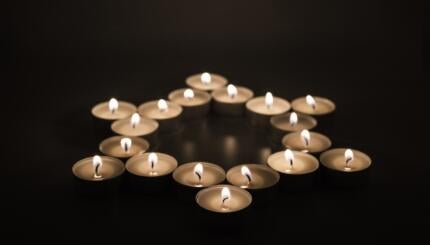“We live, each of us, to preserve our fragment, in a state of perpetual regret and longing for a place we only know existed because we remember a keyhole, a tile, the way the threshold was worn under an open door.”
– Nicole Krauss
Thousands of years ago, after our first exile in Babylonia, the Jews returned to a land and a covenant that was distant from them. Ezra the Scribe gathered the people and took out a Torah scroll and read to them what they had been missing. And the exiles wept for all that had been lost. Ezra and Nehemiah told them not to cry but to rejoice for it was Rosh Hashanah. “This day is holy to the Lord your God: you must not mourn or weep.” They were told to eat, drink and give of their portions to those who had none. The mood changed from one of guilt and sorrow to one of celebration.
A few weeks later, the people were told to go to the mountains and bring leafy branches to construct sukkot, booths to remind them of life in the wilderness. “The whole community that returned from the captivity made booths and dwelt in the booths – the Israelites had not done so from the days of Joshua son of Nun to that day – and there was very great rejoicing.” It must have been a remarkable scene, watching the Israelites after years of exile, rejoicing together in their sukkot, recreating Jewish life from fragments.
Nicole Krauss, in her novel
Great House
, captures some of the joy and the pain of a house you once knew that is reconstructed in your memory, the only place in which it exists. We live, she says, to preserve a fragment of a memory and those fragments are made up of the small pieces of our lives that we are trying somehow to return to.
Each year when we build a sukkah, we are trying to recapture the fragments of ancient life in a wilderness, a historical landscape we never experienced. It is a house of our imagination but also built on real memories. We take out the faded decorations that were made by our children years ago. And we understand that building this strange house is the way we erect an altar to layers of memory. We physically put ourselves inside this memory house and live in it for a week.
There is a custom to begin building a sukkah right after Yom Kippur is finished. I personally recommend breaking your fast before getting out the hammer, but the sentiment makes a great deal of sense. Yom Kippur drains us physically and mentally. It puts us in close contact with our mortality. It sobers us up. When we are finished petitioning God and beating our chests with our wrongdoings, we need to rebuild ourselves and we do so by building a house of joy. Every year at this time I quote Rabbi Shlomo Carlebach, who famously explained this custom this way: “If you’re a new person, you need a new house.”
Not just any house. The house that we build will only be temporary and not fancy in any way. It is a house where we are mandated to invite a lot of people to join us precisely because our new house is not fancy. The sukkah reminds us that the core of a Jewish house is the table and the people around it. It’s never the carpet, the paint or the furniture. Those are just incidentals. The sukkah helps us filter what is essential to a Jewish house and what is not. And we have a custom on Sukkot to read ushpizin, prayers that welcome our ancestors into our sukkah. Our guests are not only the living but also our historical role-models, and this invitation makes us pause. Is my house a home where Abraham and Sarah would feel comfortable? Is it a place where Torah is shared and joy is doubled through song?
“And there was very great rejoicing.” Those who built sukkot for the first time after exile must have experienced the tang of newness and the slight cringe of having lost something that they were trying desperately to recapture. Once built, they understood that the sukkah is our Jewish house of memory and joy.
sukkah
Pronounced: SOO-kah (oo as in book) or sue-KAH, Origin: Hebrew, the temporary hut built during the Harvest holiday of Sukkot.
Sukkot
Pronounced: sue-KOTE, or SOOH-kuss (oo as in book), Origin: Hebrew, a harvest festival in which Jews eat inside temporary huts, falls in the Jewish month of Tishrei, which usually coincides with September or October.
Torah
Pronunced: TORE-uh, Origin: Hebrew, the Five Books of Moses.
Yom Kippur
Pronounced: yohm KIPP-er, also yohm kee-PORE, Origin: Hebrew, The Day of Atonement, the holiest day on the Jewish calendar and, with Rosh Hashanah, one of the High Holidays.


